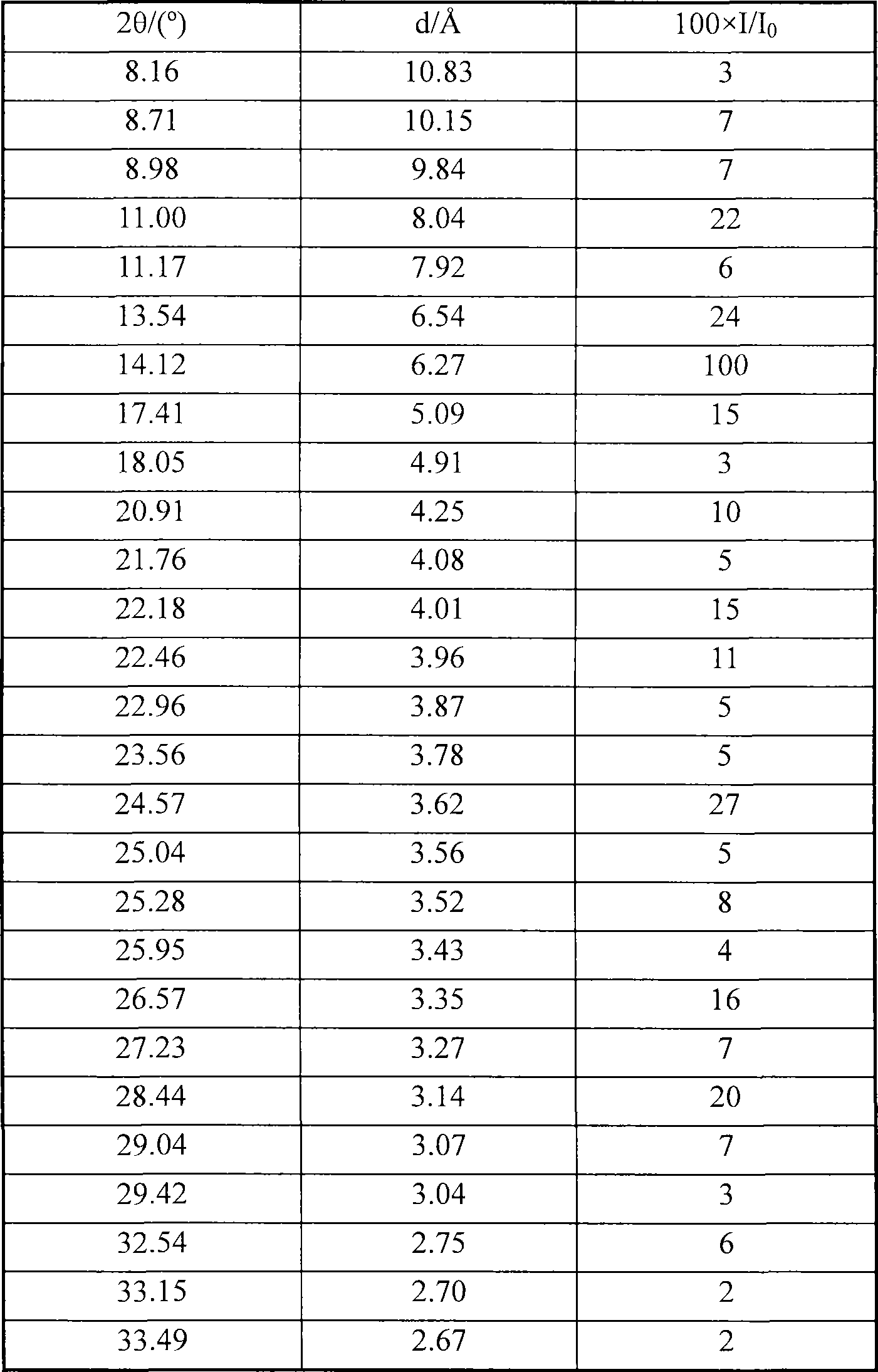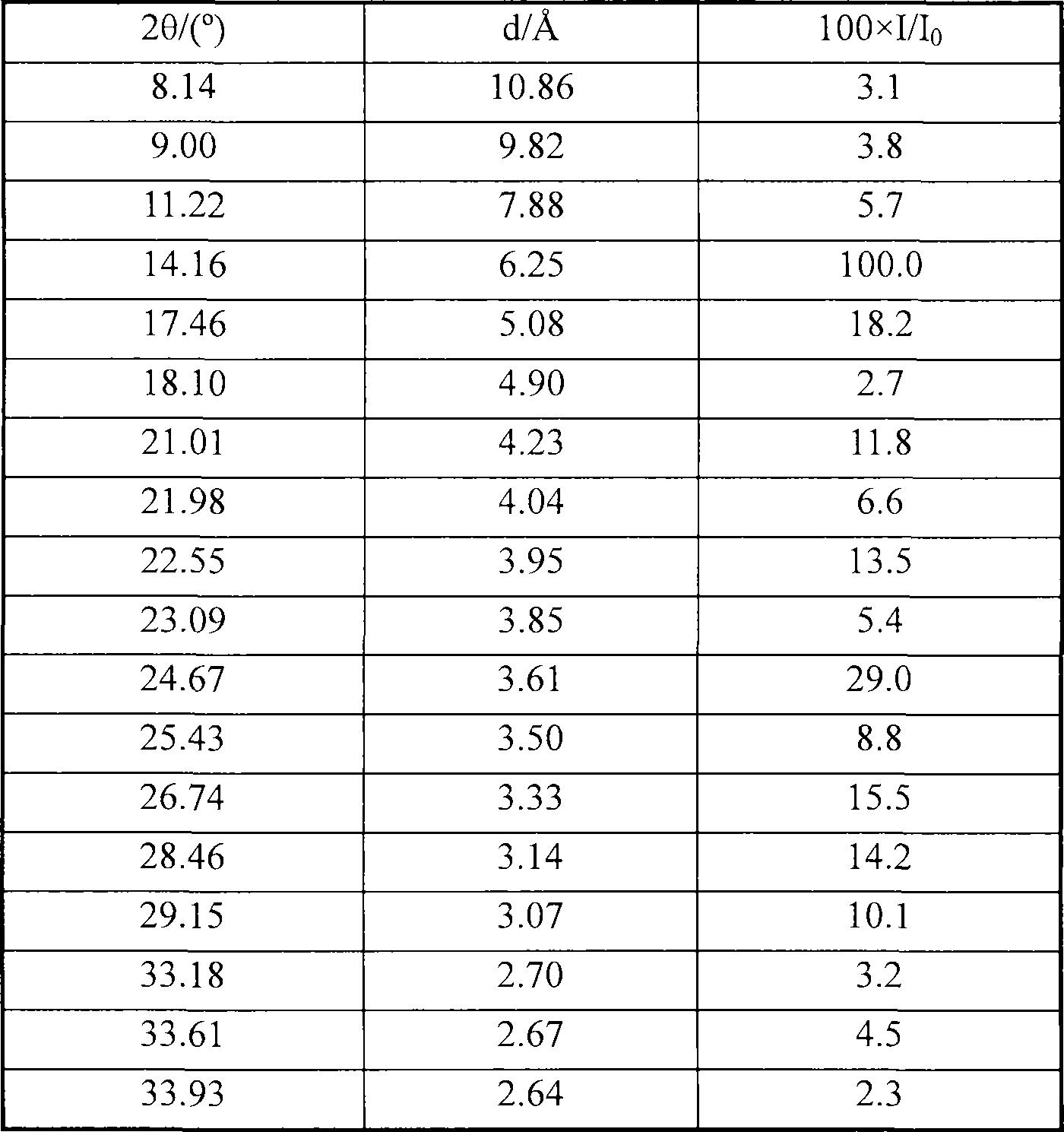Method for synthesizing SAPO-35 molecular sieve by using bi-template
A technology of SAPO-35 and molecular sieve, which is applied in the direction of molecular sieve and alkali exchange phosphate, molecular sieve characteristic silicoaluminophosphate, etc., can solve the problems of long crystallization time, achieve high thermal stability, hydrothermal stability, and high specific surface area Effect
- Summary
- Abstract
- Description
- Claims
- Application Information
AI Technical Summary
Problems solved by technology
Method used
Image
Examples
Embodiment 1
[0033] 22.1g phosphoric acid (containing H 3 PO 4 85w%, industrial product) and 77.8g deionized water are added in the gel forming kettle and mixed and stirred evenly under the condition of 60 ℃, after stirring for 10 minutes, 14.6g of hydrated aluminum oxide (containing Al 2 o 3 70w%), continue to stir for no less than 1 hour, then add 7.2g silica sol (containing SiO 2 25w%) and stirred for 0.5 hour, and then the mixture of (8.4g hexamethyleneimine+2.1g cyclohexylamine) was added into the above-mentioned gelling kettle and mixed evenly to prepare a reaction mixture. The above-mentioned part of the mixed material was transferred into a stainless steel crystallization kettle and sealed, and rotated and dynamically crystallized at 200° C. under autogenous pressure for 24 hours. The crystallized product is then filtered, washed, and dried at 100-110°C to obtain the molecular sieve raw powder product A1. The X-ray powder diffraction measurement results of A1 are consistent wit...
Embodiment 2
[0047] In Example 1, change 7.2g silica sol to 14.4g silica sol, change 77.8g deionized water to 72.3g deionized water, then change (8.4g hexamethyleneimine+2.1g cyclohexylamine) to (10.5g hexamethyleneimine + 4.5g cyclohexylamine), the gelation temperature is 55°C, and 1.4g SAPO-35 molecular sieve is added as a seed crystal, the rest of the components and synthesis conditions remain unchanged, and the product is analyzed by XRD It is SAPO-35 molecular sieve. The specific surface area of the molecular sieve after calcination to remove the template agent is 493m 2 / g, the pore volume is 0.25ml / g.
Embodiment 3
[0049] In Example 1, change 7.2g silica sol to 24g silica sol, change 77.8g deionized water to 65.1g deionized water, then change (8.4g hexamethyleneimine+2.1g cyclohexylamine) to (10.5g hexamethyleneimine + 4.5g cyclohexylamine), the gelation temperature is 65°C, and 1.52g SAPO-35 molecular sieve is added as a seed crystal, the remaining components and synthesis conditions remain unchanged, and the product is analyzed by XRD as SAPO-35 molecular sieve. The specific surface area of the molecular sieve after calcination to remove the template agent is 490m 2 / g, the pore volume is 0.25ml / g.
PUM
| Property | Measurement | Unit |
|---|---|---|
| specific surface area | aaaaa | aaaaa |
| specific surface area | aaaaa | aaaaa |
| specific surface area | aaaaa | aaaaa |
Abstract
Description
Claims
Application Information
 Login to View More
Login to View More - R&D
- Intellectual Property
- Life Sciences
- Materials
- Tech Scout
- Unparalleled Data Quality
- Higher Quality Content
- 60% Fewer Hallucinations
Browse by: Latest US Patents, China's latest patents, Technical Efficacy Thesaurus, Application Domain, Technology Topic, Popular Technical Reports.
© 2025 PatSnap. All rights reserved.Legal|Privacy policy|Modern Slavery Act Transparency Statement|Sitemap|About US| Contact US: help@patsnap.com



